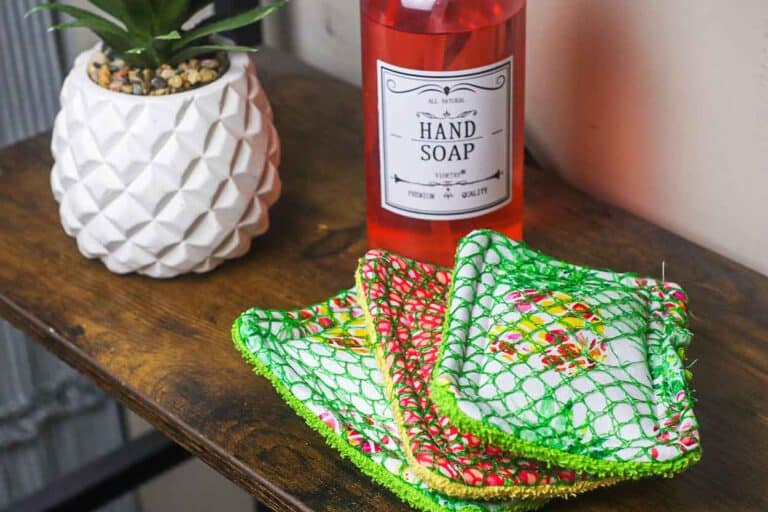See tutorial:
Turning old towels or absorbent cotton into reusable dishcloths is one of the best sewing projects to save money around the house.
Instead of repeatedly buying rolls of paper towels which add up over time you’ll have sturdy cloths that can be washed and reused for years.
These homemade dishcloths are highly effective for wiping spills, cleaning counters, and scrubbing dishes.
By choosing absorbent fabrics such as terry cloth or old flannel, you create a cleaning tool that is often more durable and more efficient than disposable alternatives.
This not only keeps more money in your pocket but also reduces household waste and your reliance on single-use paper products
2. Cloth Napkins

See tutorial:
Sewing your own cloth napkins from fabric remnants or inexpensive cotton is a practical way to upgrade mealtimes while trimming your grocery bill. Paper napkins may seem cheap, but regular purchases quickly add up.
Cloth napkins, on the other hand, can be washed and reused hundreds of times, making them a one-time investment of time and materials.
They are also sturdier and more absorbent, making them ideal for family dinners, picnics, or even entertaining guests.
You can personalize them to suit your table décor or seasonal themes, creating a polished dining experience without the recurring expense of disposable products.
3. Microwave Bowl Cozies
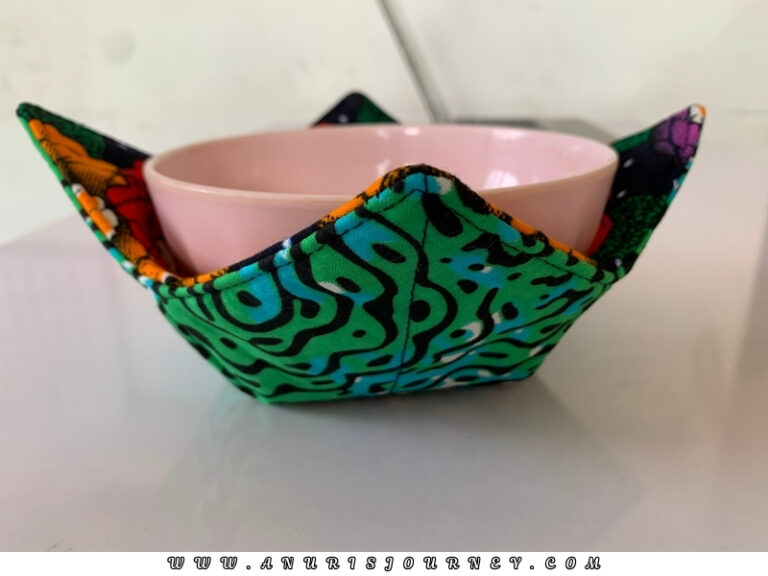
See tutorial:
Microwave bowl cozies are padded fabric holders designed to protect your hands when handling hot bowls straight from the microwave.
These are excellent sewing projects to save money around the house because they replace store bought versions an use simple materials.
These cozies prevent burns and make it easier to carry hot soup, oatmeal, or leftovers.
The small upfront cost of materials is minimal compared to store-bought options, and because they are washable and long-lasting, you save money over time while adding a custom touch to your kitchen accessories.
4. Reusable Produce Bags

See tutorial:
Grocery shopping often involves using single-use plastic produce bags, which are both wasteful and require constant replenishment.
By sewing lightweight mesh or cotton drawstring bags, you create a durable alternative that you can bring to the store again and again.
These reusable bags are perfect for fruits, vegetables, and bulk dry goods.
They not only help you avoid the hidden costs of constantly using disposable plastic bags (some stores even charge for them) but also reduce your household’s environmental footprint.
Over time, these handmade bags eliminate the need to purchase pre-made eco-friendly versions, saving you money while supporting sustainable habits.
5. Table Runners & Placemats

See tutorial:
Decorating your dining area for holidays or special occasions can get expensive if you regularly buy new table linens.
Sewing your own table runners and placemats from leftover fabric or affordable materials allows you to refresh your décor at little cost.
You can customize colors, patterns, and sizes to perfectly match your home’s style or to suit the season.
Because these pieces are washable and reusable, you save money by avoiding disposable or store-bought seasonal items year after year.
This project also lets you repurpose fabric scraps that might otherwise go to waste.
6. Reusable Snack Bags
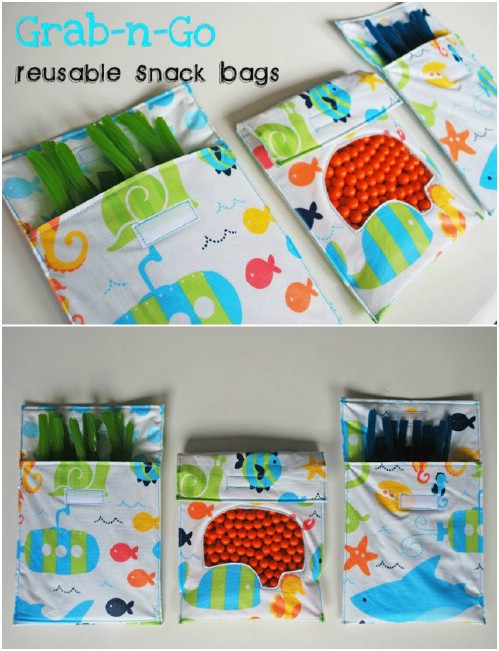
See tutorial:
Homemade reusable snack bags are a clever alternative to disposable plastic sandwich or snack bags, which can be costly over time and create unnecessary waste.
By sewing small pouches lined with food-safe, washable material (like PUL or nylon), you can pack snacks, sandwiches, or even dry ingredients for school, work, or travel.
These bags can be wiped clean or machine washed, allowing repeated use for years.
The initial sewing effort quickly pays off as you no longer need to buy boxes of disposable zip-top bags, making this project both budget-friendly and eco-conscious.
7. Laundry Bags

See tutorial:
Sewing your own sturdy drawstring laundry bags is an easy way to avoid buying expensive hampers or plastic baskets, especially for sorting clothes or carrying laundry to and from a laundromat.
You can choose durable fabrics such as canvas, old sheets, or heavy cotton, which are not only cost-effective but also machine washable and long-lasting.
These bags are lightweight, easy to store when not in use, and can be customized in size or color to fit your needs whether for delicate items, kids’ clothes, or sports gear.
By making them yourself, you save on the cost of store-bought laundry organizers and avoid the frequent replacements that cheaper plastic hampers often require.
8. Dryer Balls (Fabric Version)
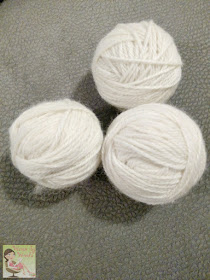
Making fabric dryer balls is one of those sewing projects to save money around the house that also lowers your energy bill by reducing drying time.
These fabric or wool balls help separate clothes as they tumble, reducing static and speeding up drying time, which saves energy and lowers your electricity bill.
Unlike dryer sheets that need constant repurchasing, fabric dryer balls last for years and require no added chemicals or fragrances.
Sewing them yourself is simple and far cheaper than buying commercial versions, making this project both eco-friendly and wallet-friendly.
9. Ironing Board Cover
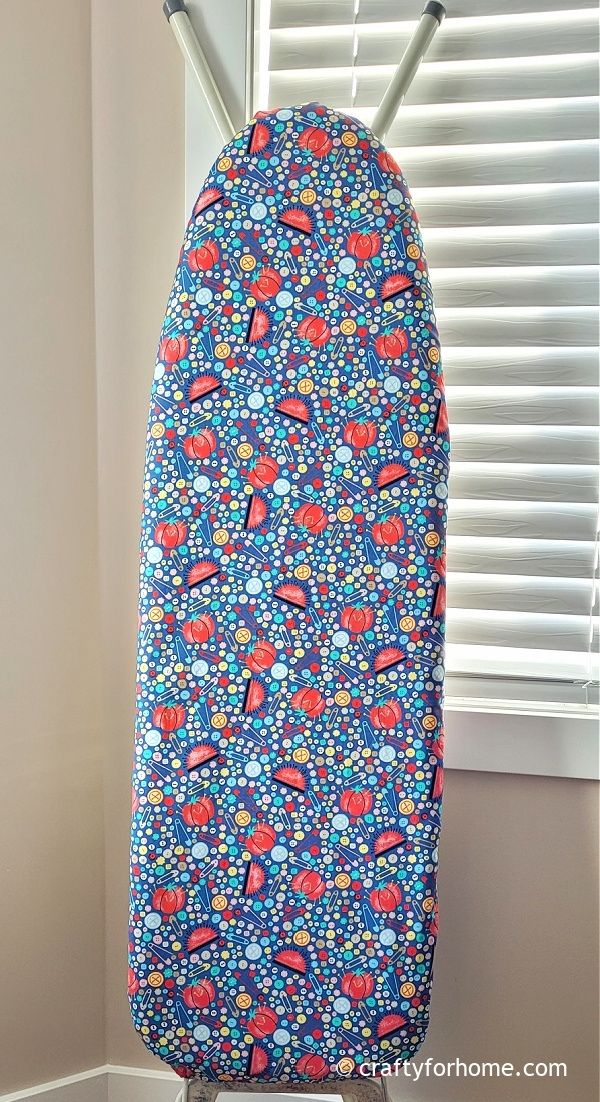
Instead of replacing an entire ironing board when the cover wears thin or gets stained, you can refresh it with a custom-fitted cover sewn from heat-resistant cotton and padded batting.
A homemade cover can be tailored exactly to your board’s size and fastened securely with elastic or ties, giving you a smooth, sturdy surface for better ironing.
This not only saves the significant cost of purchasing a new board or a pricey ready-made cover but also allows you to repurpose fabric you already have.
It extends the life of your ironing equipment and adds a personalized touch to your laundry space at minimal expense.
10. Reusable Cleaning Pads
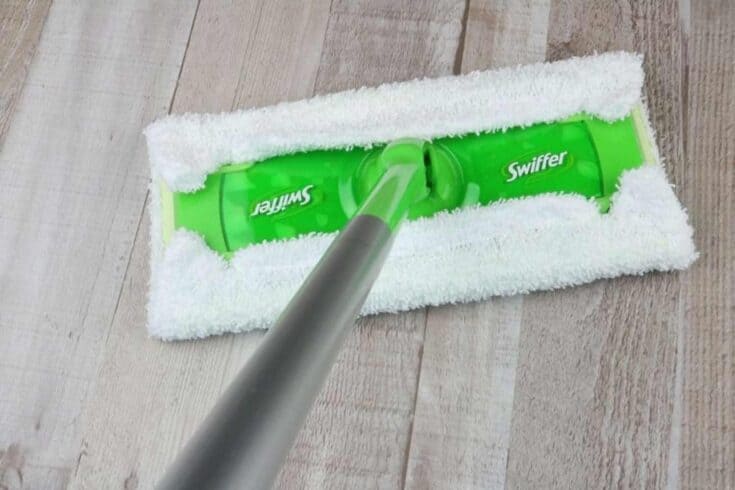
See tutorial:
If you use mop or duster systems like Swiffer, sewing your own reusable cleaning pads from microfiber cloths, fleece, or old towels is a smart way to cut ongoing costs.
Disposable pads add up quickly, but homemade versions can be machine washed and reused countless times.
They work just as effectively for dusting floors, cleaning spills, or wiping surfaces, and you can make several at once to always have a clean pad ready.
By repurposing scrap fabrics or inexpensive microfiber towels, you reduce waste, avoid the recurring expense of disposable refills, and make your cleaning routine more sustainable and cost-effective.
11. Washable Makeup Remover Pads
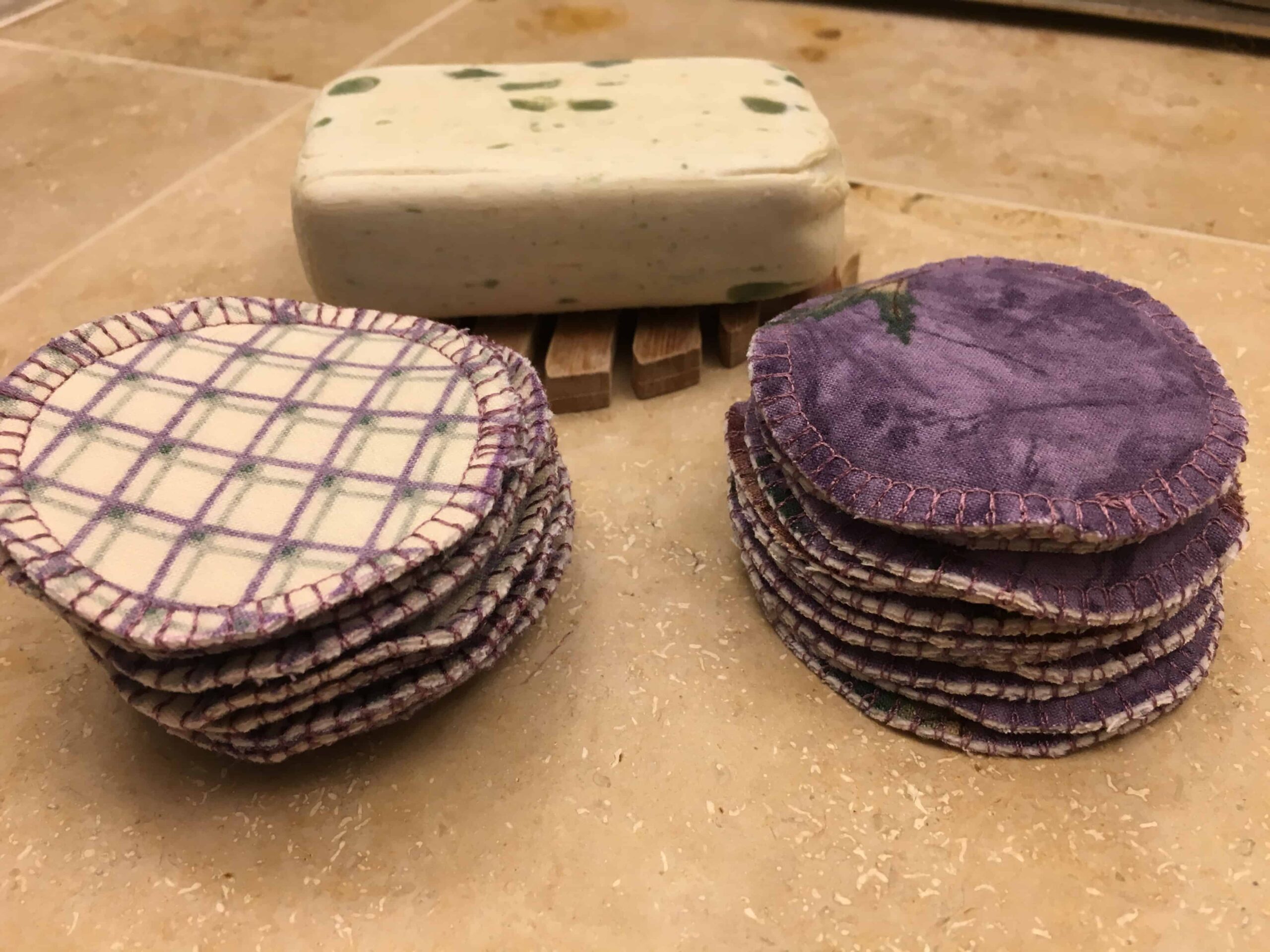
See tutorial:
Sewing your own makeup remover pads from soft flannel, terry cloth, or even old baby blankets is a small but powerful way to cut recurring expenses.
Disposable cotton pads may seem inexpensive, but regular use quickly adds up especially for anyone who wears makeup daily or uses toner.
These homemade pads can be cut into small circles or squares and sewn with a simple zigzag or serged edge to prevent fraying.
They are gentle on the skin, machine washable, and can be reused hundreds of times, which means you’ll save money month after month while producing far less waste than with single-use pads.
12. Fabric Shower Curtain Liner
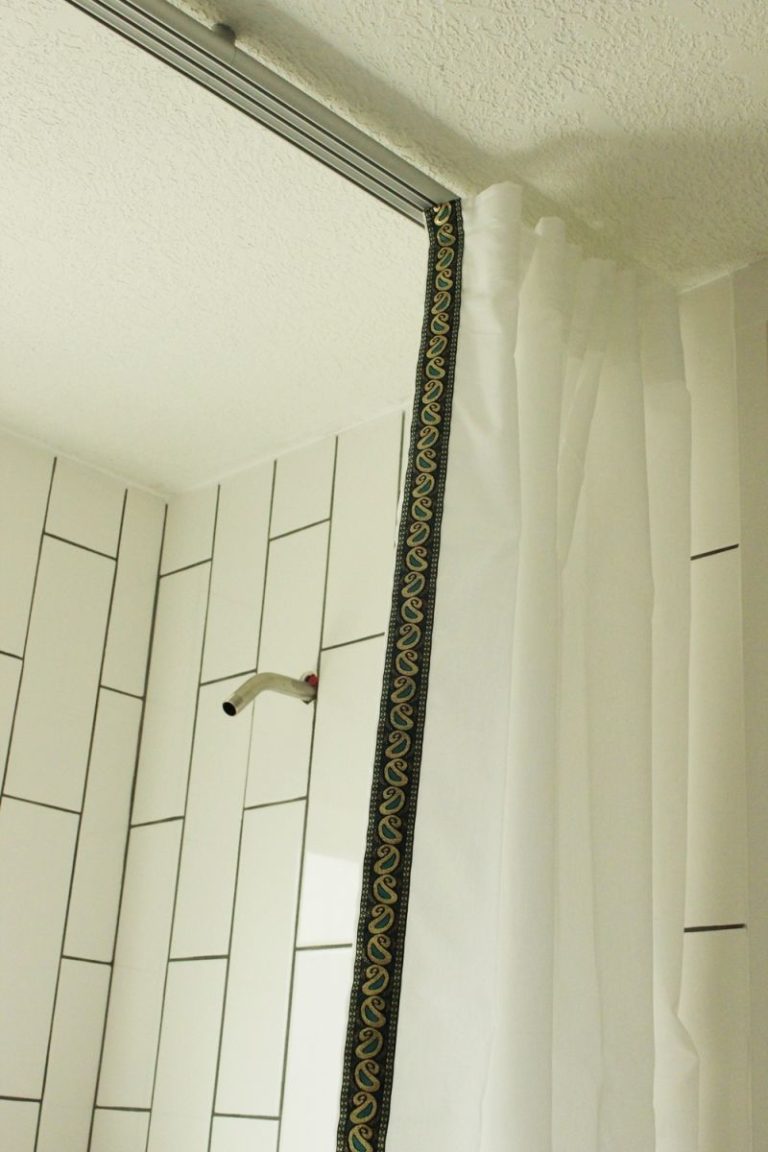
See tutorial:
Instead of constantly replacing plastic shower curtain liners that mildew and tear, you can sew a reusable liner from water-resistant or waterproof fabric such as polyester or nylon.
A fabric liner can be tossed into the washing machine to remove soap scum and mold, keeping it fresh for years.
By making one yourself, you avoid the cost of buying new liners every few months and can size it perfectly to fit your shower.
You can even choose a fabric color or pattern that complements your bathroom décor, giving you both a long-lasting solution and a more polished look at a fraction of the cost of repeated plastic replacements.
13. Bath Mat

See tutorial:
Old towels or worn-out bathrobes can be transformed into a plush, quilted bath mat with a little basic sewing.
Store-bought mats can be pricey and often lose their softness or backing after frequent washing, but a handmade version allows you to layer multiple towels for extra cushioning and absorbency.
You can quilt the layers together for durability and add a non-slip backing if desired.
This project not only saves the cost of purchasing a new mat but also gives new life to old linens that might otherwise be discarded, making it both budget-friendly and eco-conscious.
14. Hanging Toiletry Organizer

See tutorial:
Creating your own hanging toiletry organizer is one of the most practical sewing projects to save money around the house especially for frequent travelers.
By sewing your own hanging organizer, you can create as many pockets or zippered sections as you need, using sturdy fabric like canvas or denim. Add a hook or ribbon loop so it can hang conveniently on a door or towel rack.
This homemade version keeps your toiletries neatly arranged at home or on trips without the cost of buying high-end organizers.
It also allows you to repurpose fabric scraps or old jeans, saving even more money while creating a custom storage solution that perfectly fits your personal needs.
15. Drawer Organizers
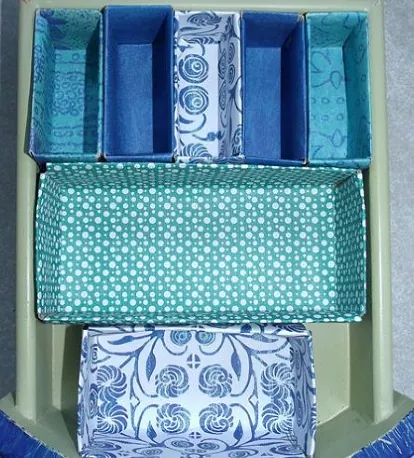
See tutorial:
Instead of purchasing expensive plastic or acrylic drawer organizers, you can sew fabric bins or dividers to keep drawers neat and clutter-free.
Using sturdy cotton, canvas, or even leftover upholstery fabric, you can create small compartments tailored to the exact size of your drawers perfect for sorting socks, underwear, office supplies, or craft items.
These handmade organizers are lightweight, washable, and can be folded flat when not in use.
By repurposing fabric scraps or old clothing, you cut the cost of store-bought organizers while making a solution that’s perfectly customized to your space and easy to refresh whenever you want a new look.
16. Fabric Baskets
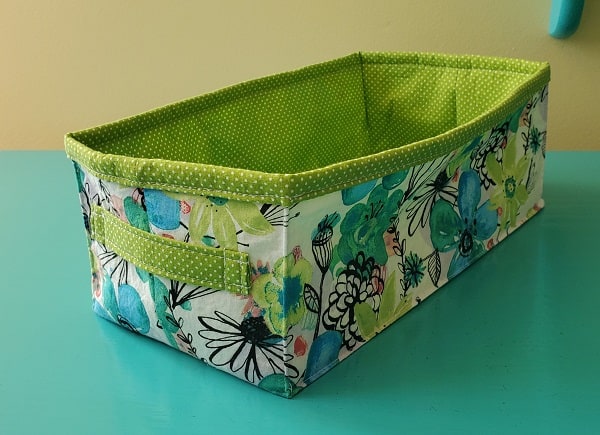
See tutorial:
Fabric baskets are a practical and stylish way to store toys, laundry, or craft supplies without buying costly woven or plastic bins.
Heavy-duty fabrics such as canvas, denim from old jeans, or even thick upholstery fabric give these baskets enough strength to hold heavier items while remaining easy to wash and maintain.
You can sew them in any size or shape, add handles for easy carrying, and line them with a coordinating fabric for a polished look.
This not only saves you money on commercial storage solutions but also allows you to repurpose durable textiles that might otherwise be thrown away.
17. Under-Bed Storage Bags
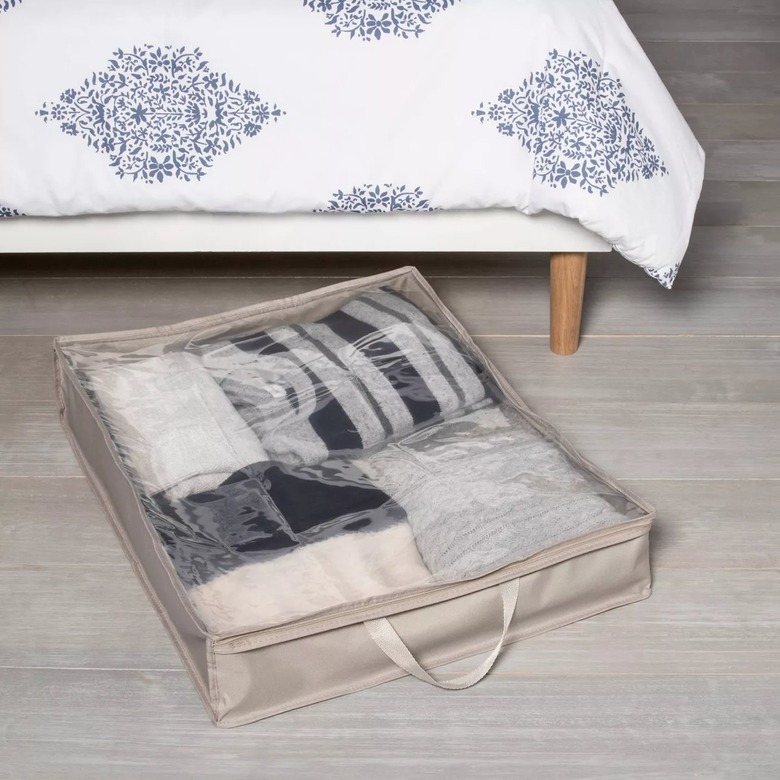
Photo credit:
Seasonal clothing, extra bedding, or out-of-season shoes often require bulky storage containers that can be expensive and take up unnecessary space.
Sewing your own under-bed storage bags from strong cotton, old sheets, or even repurposed curtains provides a low-cost alternative.
Adding zippers or drawstring closures keeps dust and pests out, while the soft-sided design lets the bags fit neatly into tight spaces.
Because you can make them to the exact dimensions of your bed or available space, they are more efficient than store-bought bins and can be easily washed or repaired.
This project saves money on plastic totes and helps you organize your home without sacrificing valuable space.
18. Cable Organizers
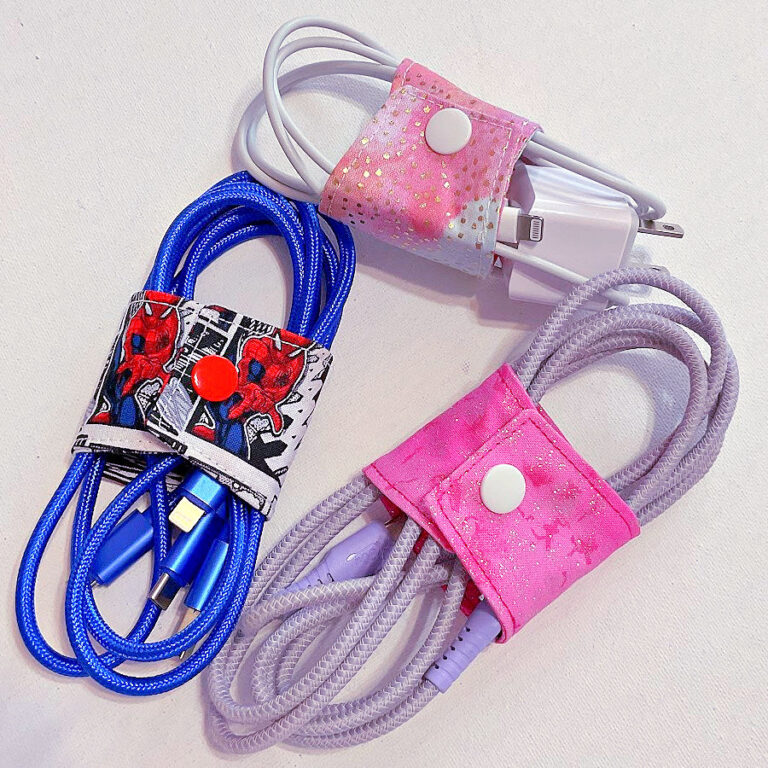
See tutorial:
Electronics cords and chargers can quickly become tangled and messy, and commercial cord organizers or cases often come with a surprisingly high price tag.
Small sewing projects to save money around the house like cable wrap or pouches help reduce clutter while preventing wear on your cords.
By sewing small Velcro wraps, elastic bands, or zippered pouches from fabric scraps, you can neatly bundle cables for travel or home storage.
They are quick to make, require only small pieces of fabric, and can be tailored to different cord sizes.
This inexpensive DIY alternative saves money while keeping your workspace or travel bag tidy and frustration-free.
19. Throw Pillow Covers
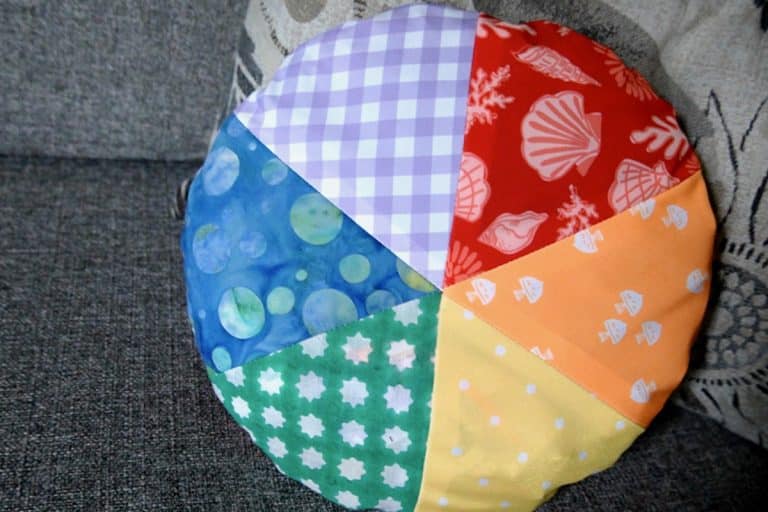
See tutorial:
Instead of spending money on new decorative pillows whenever you want to refresh your living room or bedroom, you can sew removable covers for the pillows you already own.
Using fabric remnants, old curtains, or even repurposed clothing, you can easily create covers with zippers, buttons, or envelope-style closures.
This allows you to change colors and patterns with the seasons or for special occasions without the cost or clutter of buying extra pillows.
Because the covers can be removed and washed, they also extend the life of your existing pillows, saving money on replacements while keeping your home décor stylish and fresh.
20. Draft Stoppers (Door Snakes)
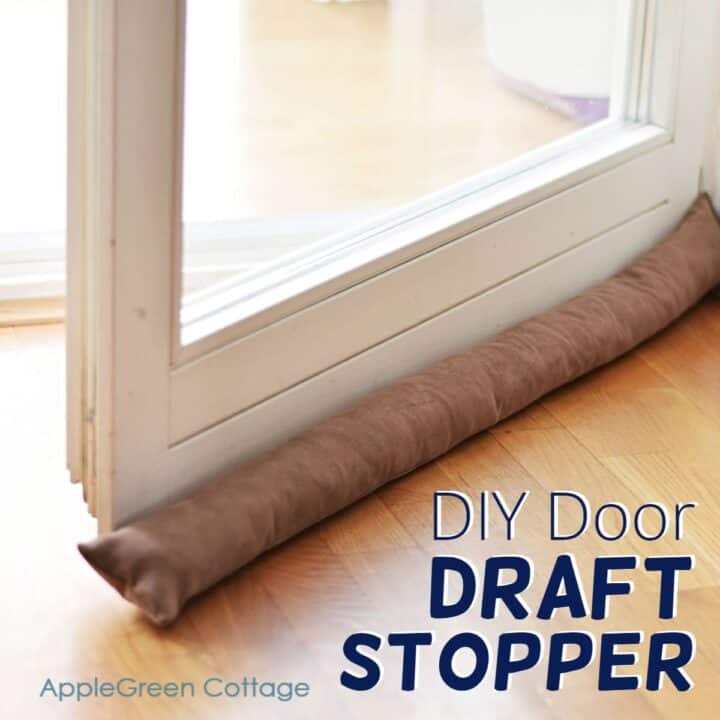
See tutorial:
A draft stopper also called a door snake is a simple fabric tube filled with rice, sand, or even old fabric scraps that you place along the bottom of doors or windows to block cold air from entering.
By preventing drafts, these stoppers reduce the strain on your heating system, which can lower your energy bills, especially in cooler months.
Store-bought versions can be surprisingly expensive, but sewing your own lets you customize the size and fabric to match your décor.
It’s an inexpensive way to improve your home’s energy efficiency while repurposing scrap fabric or worn-out clothes.
21. Curtains or Curtain Tiebacks

See tutorial:
Making your own curtains is a cost-effective way to transform a room without spending a fortune on store-bought window treatments.
With basic sewing skills, you can turn affordable fabric or even repurposed bedsheets into elegant drapes tailored to your exact window size. You can also sew simple tiebacks from matching or contrasting fabric to add a decorative touch.
Custom curtains not only give you full control over the style, length, and pattern but also often cost significantly less than ready-made or custom-ordered curtains.
They can help insulate your home and protect furniture from sun damage, saving money on both décor and utility bills.
22. Quilt or Patchwork Blanket

See tutorial:
Creating a quilt or patchwork blanket from fabric scraps, worn clothing, or old linens is a classic sewing project that saves money while producing a functional, heirloom-quality piece.
Store-bought quilts or decorative throws can be costly, but a handmade version allows you to recycle materials you already have, turning sentimental fabrics into a cozy, practical blanket.
You can customize the size, pattern, and thickness, making it ideal for beds, couches, or outdoor picnics.
Besides saving on the purchase of a new blanket, this project extends the life of fabrics that might otherwise be discarded and gives your home a personal, one-of-a-kind touch.
23. Reusable Shopping Bags
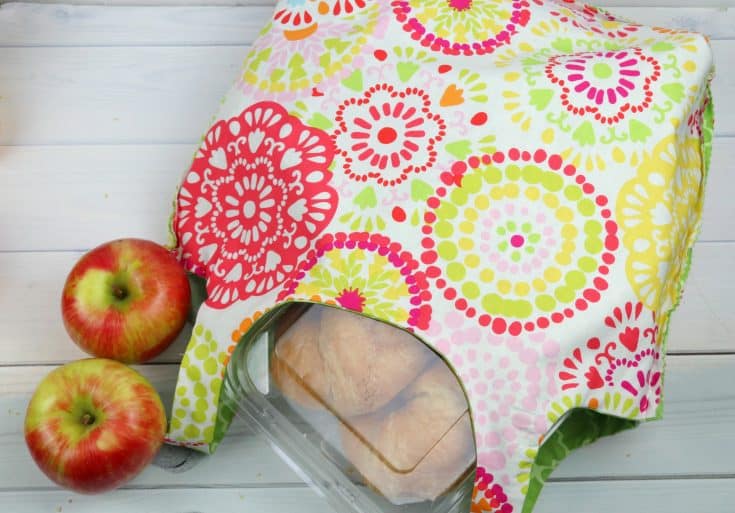
See tutorial:
Sewing your own reusable shopping bags is a practical way to avoid constantly buying store-branded tote bags or paying for single-use plastic bags.
Using durable fabrics such as canvas, denim, or even old curtains, you can create strong, washable totes that last for years.
These bags are perfect for groceries, farmers’ markets, or everyday errands and can be made in a variety of sizes to suit your needs.
By making them yourself, you save money over time and reduce the environmental impact of disposable bags.
Plus, homemade totes can be customized with unique fabrics or patterns, giving you a personal touch while avoiding the cost of high-end reusable bags.
24. Aprons
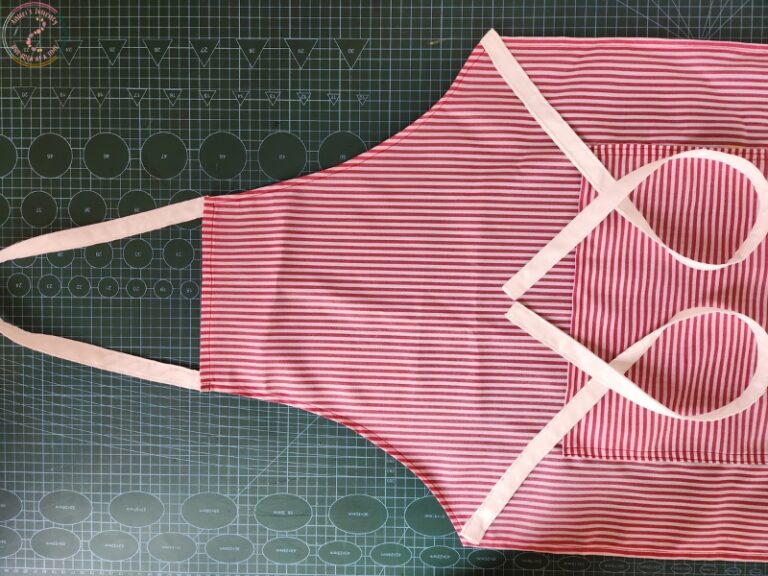
See tutorial:
Homemade aprons are an easy way to protect your clothes during cooking, gardening, or craft projects, which ultimately saves you money by reducing wear-and-tear or the need to replace stained clothing.
Sewing an apron from sturdy fabrics like canvas, denim, or repurposed tablecloths allows you to tailor the design with pockets, adjustable neck straps, or ties to suit your specific activities.
Store-bought aprons can be surprisingly pricey, especially those with extra features, but a handmade apron provides the same protection at a fraction of the cost.
It’s also a great way to use leftover fabric while creating something both functional and stylish.
25. Fabric Belts or Sashes
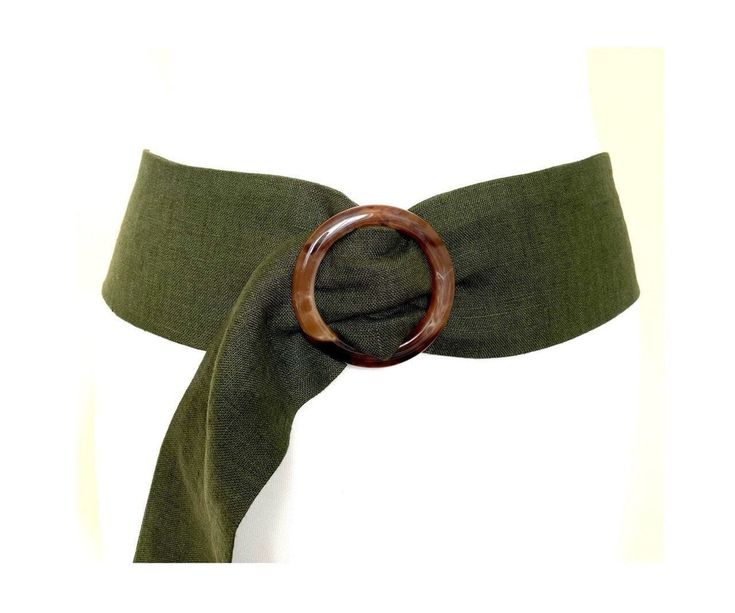
These fabric accessories are perfect examples of sewing projects to save money around the house, helping you refresh your wardrobe without new purchases.
By using fabric scraps, old scarves, or even strips of denim, you can create belts in different colors and patterns to match multiple outfits.
These accessories can instantly change the look of a dress or tunic and help garments fit better without spending on store-bought belts. They are also adjustable and washable, making them both practical and long-lasting.
With just a little sewing, you can refresh your wardrobe and save money on new accessories.
26. Simple Elastic Waist Skirt or Pajama Shorts

See tutorial:
Sewing a basic elastic waist skirt or a pair of pajama shorts is an inexpensive way to add comfortable clothing to your wardrobe without buying new casual wear.
Leftover fabric, old sheets, or upcycled garments can be easily transformed into these simple pieces using only basic sewing skills.
Elastic waistbands make the fit forgiving and comfortable, and you can customize the length, pattern, and style to your liking.
These handmade garments save money by reducing the need to purchase store-bought loungewear or summer clothes and give you the satisfaction of creating clothing tailored to your exact measurements.
27. Pet Bed Covers
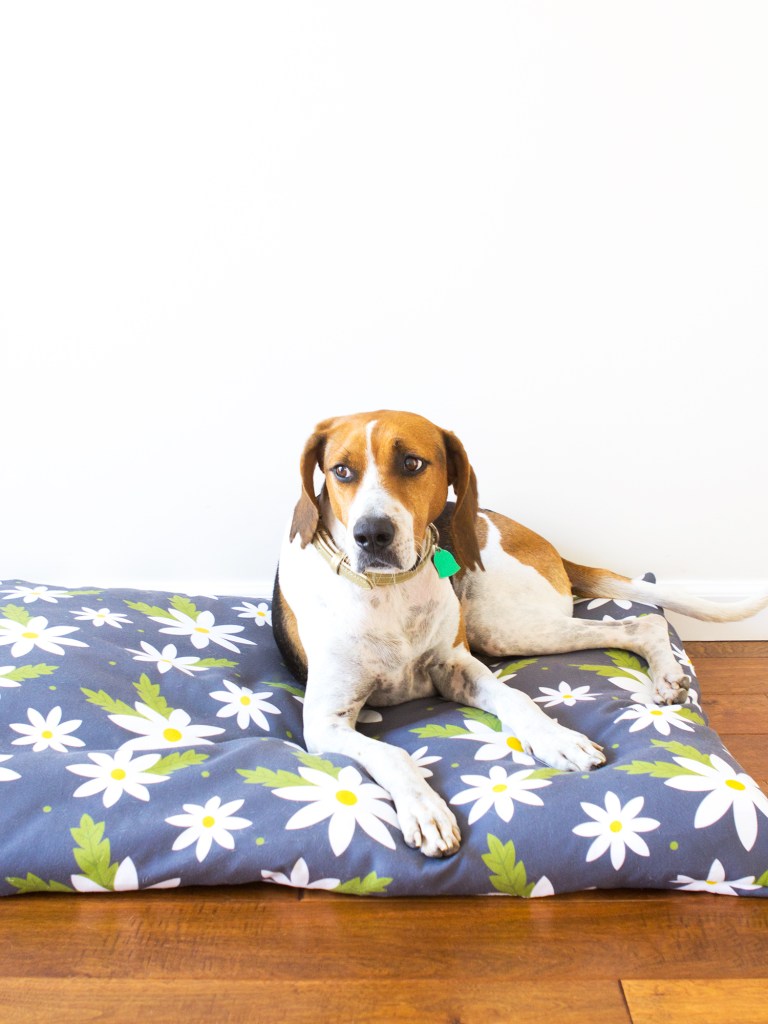
See tutorial:
Pets can be tough on bedding, and buying entirely new beds every time the cover gets dirty or worn can become expensive.
By sewing removable, washable covers from sturdy fabrics like canvas, denim, or upholstery material, you can protect the inner cushion and extend the life of the bed itself.
These covers can be made with zippers or envelope-style closures for easy removal and cleaning.
Not only does this save you the cost of frequently replacing pet beds, but it also helps keep your home smelling fresh and looking tidy.
Using leftover fabric or old blankets makes this project even more budget-friendly and sustainable.
28. Picnic Blanket

See tutorial:
A reusable picnic blanket made from fabric scraps combined with waterproof backing such as a repurposed shower curtain or vinyl tablecloth provides a durable, cost-effective alternative to store-bought outdoor mats.
You can quilt together leftover fabric for a colorful top layer and attach a water-resistant underside to keep you dry on damp grass.
This project saves money by repurposing materials you may already own and eliminates the need for expensive picnic gear.
A homemade blanket is also easy to fold and wash, making it perfect for outdoor events, beach trips, or even family movie nights in the yard.
29. Garden Tool Roll

See tutorial:
Gardeners often spend a surprising amount on specialized tool storage, but a simple fabric tool roll can be sewn at home for a fraction of the cost.
Using sturdy, washable fabric such as canvas or old jeans, you can create a roll-up organizer with individual pockets for hand tools, gloves, and seed packets. Adding a tie or Velcro strap makes it easy to secure and carry.
This DIY solution not only keeps your tools neatly arranged and protected but also prevents damage or loss, extending their lifespan and saving you money on replacements.
It’s a practical, low-cost way to keep gardening supplies organized.
30. Reusable Sandwich Wraps
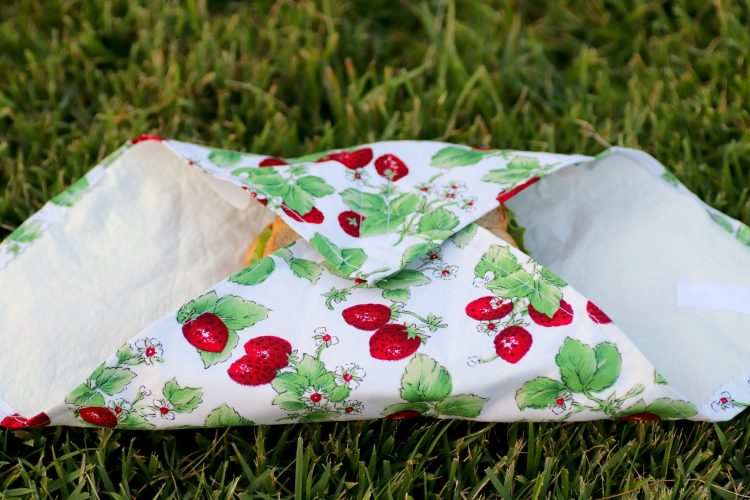
See tutorial:
Instead of buying disposable plastic wrap, cling film, or aluminum foil for lunches, you can sew reusable sandwich wraps from cotton fabric lined with a wipeable, food-safe material such as PUL or coated nylon.
These wraps fasten with Velcro or snaps and can be wiped clean or machine washed after use.
They are lightweight, fold easily to fit in lunch bags, and can double as placemats. Over time, they eliminate the recurring cost of single-use wrapping materials while reducing household waste.
This simple project is not only eco-friendly and budget-conscious but also lets you create fun, customized designs for school or work lunches.
You may also be interested to see:
